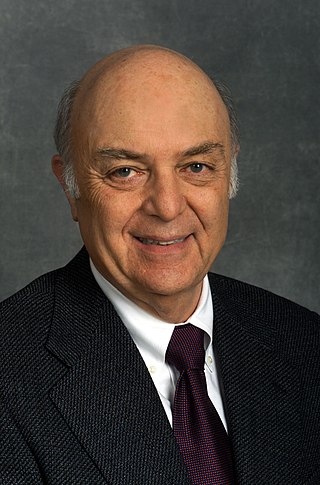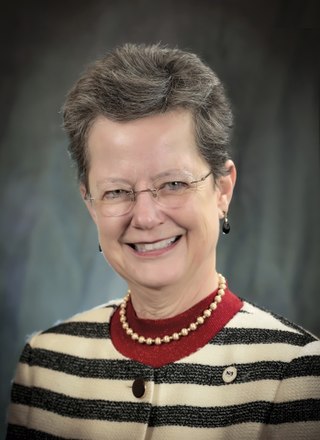See also
- Leslie Kolodziejski, fellow MIT physicist and collaborator of Joannopoulos
John Joannopoulos | |
|---|---|
| Born | April 26, 1947 New York, New York, U.S. |
| Alma mater | University of California, Berkeley |
| Scientific career | |
| Fields | Physics |
| Thesis | Electronic structure of complex crystalline and amorphous semiconductors (1974) |
| Doctoral advisor | Marvin L. Cohen |
| Doctoral students | |
John D. Joannopoulos (born April 26, 1947) is an American physicist, focused in condensed matter theory. He is currently the Francis Wright Davis Professor of Physics at Massachusetts Institute of Technology, an Elected Member of the National Academy of Sciences (NAS), an Elected Member of the American Academy of Arts and Sciences (AAA&S), and an Elected Fellow of the American Association for the Advancement of Science (AAAS) and American Physical Society (APS).
Joannopoulos was born on April 26, 1947 in New York City to Greek parents. [1] He is the recipient of numerous awards and honors. Most recently, in 2015, the Optical Society of America (OSA) awarded him the Max Born Award and the APS awarded him the Aneesur Rahman Prize for Computational Physics, both significant awards. [2] [3] [4] [5] [6]
Joannopoulos is also the director of the Institute for Soldier Nanotechnologies. He first gained that position in 2006. [7]
Joannopoulos has been on the MIT faculty since 1974. He holds his BA and PhD from the University of California, Berkeley, the latter received in 1974. His doctoral studies, advised by Marvin L. Cohen, focused on electronic structure of complex crystalline and amorphous semiconductors. [1]
Joannopoulos has helped set the theoretical foundations of key computational techniques for realistic and microscopic studies of complex materials systems, including the electronic, vibrational, and optical structure of crystalline and amorphous solids, their surfaces, interfaces, and defects; localization in disordered systems; and the first ab-initio studies of phase transitions and critical phenomena. In the early nineties, he also helped spawn the development of a new class of materials (photonic crystals) that provide new mechanisms to control the flow of light and have revolutionized the fields of optical and lightwave physics.[ citation needed ]
His students include Nobel Laureate Robert B. Laughlin, David Vanderbilt, Eugene J. Mele, Shanhui Fan, Steven G. Johnson, and Karin M. Rabe. [8]

Henry Frederick "Fritz" Schaefer III is an American computational, physical, and theoretical chemist. He is one of the most highly cited chemists in the world, with a Thomson Reuters h-index of 121 as of 2020.

Marvin Lou Cohen is an American–Canadian theoretical physicist. He is a physics professor at the University of California, Berkeley. Cohen is a leading expert in the field of condensed matter physics. He is widely known for his seminal work on the electronic structure of solids.
David Vanderbilt is a professor of physics at Rutgers University researching condensed-matter physics since 1991, and named Board of Governors Professor of Physics in 2009. He received his B.A. from Swarthmore College in 1976 and his Ph.D. from MIT in 1981 studying under John D. Joannopoulos. He received the Aneesur Rahman Prize for Computational Physics in 2006. The Aneesur Rahman prize is the highest honor given by the American Physical Society for work in computational physics. In 2013 he was elected to the National Academy of Science.

David Adler was an American physicist and Massachusetts Institute of Technology professor. In condensed matter physics, Adler made significant contributions to the understanding of transition-metal oxides, the electronic properties of low-mobility materials, transport phenomena in amorphous materials, metal-insulator transitions, and electronic defects in amorphous semiconductors.
Shashi P. Karna is a nanotechnology physicist who works for the United States Army Research Laboratory in Aberdeen, Maryland.
Roberto Car is an Italian physicist and the Ralph W. Dornte *31 Professor in Chemistry at Princeton University, where he is also a faculty member in the Princeton Institute for the Science and Technology of Materials. He conducts research on the simulation of molecular dynamics phenomena.

Gerbrand Ceder is a Belgian–American scientist who is a professor and the Samsung Distinguished Chair in Nanoscience and Nanotechnology Research at the University of California, Berkeley. He has a joint appointment as a senior faculty scientist in the Materials Sciences Division of Lawrence Berkeley National Laboratory. He is notable for his pioneering research in high-throughput computational materials design, and in the development of novel lithium-ion battery technologies. He is co-founder of the Materials Project, an open-source online database of ab initio calculated material properties, which inspired the Materials Genome Initiative by the Obama administration in 2011. He is also the Founder and was CTO of Pellion Technologies, which aims to commercialize magnesium-ion batteries. In 2017 Gerbrand Ceder was elected a member of the National Academy of Engineering, "For the development of practical computational materials design and its application to the improvement of energy storage technology."

Jun Ye is a Chinese-American physicist at JILA, National Institute of Standards and Technology, and the University of Colorado Boulder, working primarily in the field of atomic, molecular, and optical physics.

Brent Fultz is an American physicist and materials scientist and one of the world's leading authorities on statistical mechanics, diffraction, and phase transitions in materials. Fultz is the Barbara and Stanley Rawn Jr. Professor of Applied Physics and Materials Science at the California Institute of Technology. He is known for his research in materials physics and materials chemistry, and for establishing the importance of phonon entropy to the phase stability of materials. Additionally, Fultz oversaw the construction of the wide angular-range chopper spectrometer (ARCS) instrument at the Spallation Neutron Source and has made advances in phonon measuring techniques.
David Alan Drabold is an American physicist, currently Edwin and Ruth Kennedy Distinguished Professor at Ohio University.
Kate Page Kirby is an American physicist. From February 2015 to December 2020, Kirby was the chief executive officer of the American Physical Society (APS) and sits on the board of directors of the American Institute of Physics. Kate Kirby was elected a fellow of the American Physical Society (APS) in 1989 for her "innovative application of methods of quantum chemistry to the quantitative elucidation of a diverse range of molecular phenomena." She was made a fellow of the American Association for the Advancement of Science (AAAS) in 1996 for her contributions to physics.
Bulbul Chakraborty is the Enid and Nate Ancell Professor of Physics at Brandeis University. She is recognized for her contributions to soft condensed matter theory studying systems far from equilibrium, such as granular materials, amorphous systems, and statistical physics. She is an elected American Physical Society and American Association for the Advancement of Science fellow.
Shanhui Fan is a Chinese-born American electrical engineer and physicist, with a focus on theoretical, computational and numerical aspects of photonics and electromagnetism. He is a professor of electrical engineering, and a professor of applied physics at Stanford University. He is the director of the Edward L. Ginzton Lab and Senior Fellow at the Precourt Institute for Energy.
Pablo Jarillo-Herrero is a Spanish physicist and current Cecil and Ida Green Professor of Physics at Massachusetts Institute of Technology (MIT).

David Tománek (born July 1954) is a U.S.-Swiss physicist of Czech origin and researcher in nanoscience and nanotechnology. He is Emeritus Professor of Physics at Michigan State University. He is known for predicting the structure and calculating properties of surfaces, atomic clusters including the C60 buckminsterfullerene, nanotubes, nanowires and nanohelices, graphene, and two-dimensional materials including phosphorene.
Karin M. Rabe is an American condensed matter and computational materials physicist known for her studies of materials near phase transitions, including ferroelectrics, multiferroics, and martensites. She also works on the theoretical design of new materials. She is a distinguished professor and Board of Governors Professor of Physics at Rutgers University.

Prineha Narang is an American physicist and computational material scientist. She is a Professor of Physical Sciences and Howard Reiss Chair at the University of California, Los Angeles (UCLA). Narang currently serves as a U.S. Science Envoy approved by the Secretary of State to identify opportunities for science and technology cooperation. Before moving to UCLA, she was first an Environmental Fellow at Harvard University Center for the Environment and then an Assistant Professor in the John A. Paulson School of Engineering and Applied Sciences at Harvard University. Narang’s work has been recognized internationally by many awards and a variety of special designations, including the Mildred Dresselhaus Prize, the 2021 IUPAP Young Scientist Prize in Computational Physics, a Friedrich Wilhelm Bessel Research Award from the Alexander von Humboldt Foundation, and a Max Planck Sabbatical Award from the Max Planck Society. Narang also received a National Science Foundation CAREER Award in 2020, was named a Moore Inventor Fellow by the Gordon and Betty Moore Foundation for the development for a fundamentally new strategy for single molecule sensing and environmental toxin metrology using picoscale quantum sensors, CIFAR Azrieli Global Scholar by the Canadian Institute for Advanced Research, and a Top Innovator by MIT Tech Review. Narang was awarded a Guggenheim Fellowship in 2023.

Julia Mae Phillips is an American physicist. She began her career in materials research on thin films on semiconductors and has transitioned into leadership roles in science policy. She currently serves on the National Science Board.
Ángel Rubio is a Spanish theoretical physicist and director at the Max Planck Institute for the Structure and Dynamics of Matter in Hamburg. Rubio is also a Distinguished Research Scientist in computational quantum physics at the Simons Foundation's Flatiron Institute in New York City. He is a member of the National Academy of Sciences and a fellow of the American Physical Society.

Shawn Yu Lin is a Taiwanese American physicist, researcher, and educator who made pioneering contributions to the field of photonics and photonic crystals. He authored more than 250 technical papers.